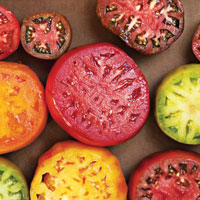Enjoy the Tastes of Heirloom Tomatoes

One of the marvels of modern American life is the ability to walk into a grocery store on any day of the year and walk out with a bright red tomato in your shopping bag.

This convenience, however, comes with a price. Oftentimes these grocery store varieties are bred for their prolonged shelf life and picked while green. While pretty, they aren’t necessarily tasty.
“I think we have no idea what tomatoes really taste like, and the variety of flavors,” says Lilly Anderson-Messec, a certified horticultural professional who teaches the annual “Totally Tomatoes” gardening class at Native Nurseries.
For the true devotee, nothing beats the flavor of a homegrown heirloom tomato. Many heirloom varieties not only taste different, but their appearance can also vary widely from the red orbs found in a grocery store. They can be tiny, huge, wrinkly, pear-shaped, striped, orange, yellow … even purple and brown.
So, what makes a tomato an heirloom? “It’s not a definite term, but generally people use the term to describe a plant that’s been coming true from seed for at least 50 years,” says Anderson-Messec. Most of the tomatoes sold in garden centers and in seed packets are hybrids. Unlike an heirloom, you can’t save the seeds and plant them the next year.
Heirloom tomatoes are a pretty good entry plant to vegetable gardening,” says Anderson-Messec. “They’re so rewarding for vegetable gardening because they’re so much better than what you get in the grocery store. When you grow kale at home it’s pretty much the same (as what you’ll find in the store). Probably more tender and tastier, but tomatoes are just worlds away.”
While purists swear by the heirloom, local tomato grower Tom Zingale says hybrid varieties have their advantages, and he plants some in his urban garden every year. Hybrids are more blight resistant, he says, particularly here, where Florida’s humidity makes them more prone to disease.
It’s way too late now to start from seed or a small plant — intense summer heat is the death knell for tomatoes. Zingale plants his “no later than St. Patrick’s Day,” although some nurseries have larger plants in gallon-sized containers you can buy now that would produce fruit this year.
Your best bet for getting heirloom tomatoes is to buy them at the weekly farmer’s markets around town. A great opportunity to try some of the region's best tomatoes comes when Turkey Hill Farms holds its annual Tomato Feastival June 9.
Local Heirloom Favorites
- Jaunne Flamme — Four-ounce fruits with bright orange skin. Early to ripen.
- Speckled Roman — Red with yellow stripes. Meaty, with few seeds and little water. Great for sauces or on sandwiches.
- Paul Robeson — Dark purple, it’s one of the few big varieties that is very productive.
- Matt’s Wild Cherry — Red cherry tomatoes packed with an intense, sweet and full flavor.
- Cherokee Purple — From reddish purple to brown in color. Larger than many heirloom varieties with an earthy, sweet taste.
- Black Cherry — Dark purple red cherry tomato that’s more savory than others. Produces tons of fruit throughout the growing season.
- Green Zebra — Gold with bold green stripes, golf ball-sized fruits often ranked as a top-tasting heirloom.
- Egg Yolk — About the same size and color of their namesake. Extra-long vines produce summery sweetness.
- Scarlet Topper — Scarlet red fruits weigh 5 to 10 ounces with a mild flavor.
- Dr. Marvel — Named for the man who spent 30 years working on this tomato.
- Sun Gold – Tiny cherry tomatoes the color of an orange sun. Exceptionally sweet and fruity.
- Juliet — A grape tomato that is actually a hybrid. Plum-shaped fruit are good for salads, stewing and drying.


